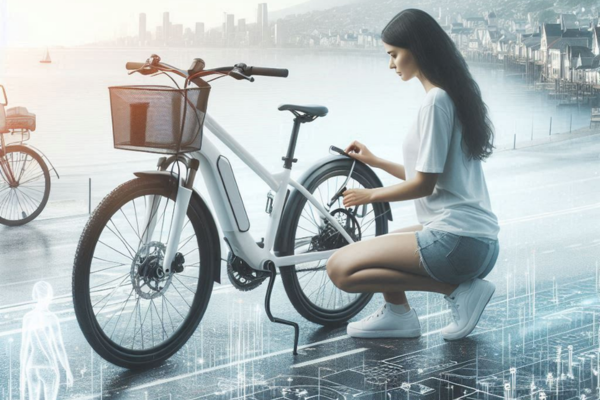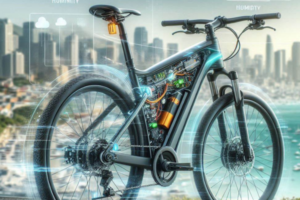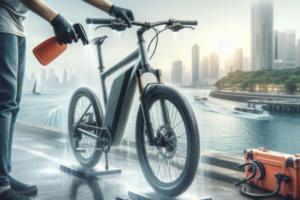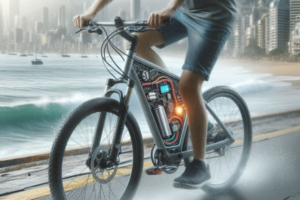Energy-Efficient Maintenance of Electric Bicycles in Coastal Cities
🌊 The Unique Challenges of Coastal Environments
Living in a coastal city offers breathtaking views, fresh ocean air, and a beautiful connection to nature — but for electric bicycle owners, it also presents a unique set of maintenance challenges. The same salty breeze and humid atmosphere that make the coast so inviting can be harsh on metal components, electrical systems, and even battery efficiency. That’s why energy-efficient maintenance isn’t just about prolonging the bike’s life — it’s also about making sure every ride consumes the least energy possible.
In cities like Santa Marta, Guayaquil, or San Juan, electric bikes are exposed to a combination of sea spray, heat, and moisture that accelerates wear and disrupts smooth performance. Salt can corrode bolts and drivetrain parts, moisture can interfere with battery terminals, and sandy particles can lodge into delicate moving parts. Without a solid maintenance routine, energy loss due to mechanical resistance and unnecessary motor effort becomes inevitable.
But here’s the good news: with consistent and focused care, you can protect your e-bike from the harsh coastal environment while optimizing its energy use. From simple cleaning techniques to strategic upgrades and riding habits, energy-efficient maintenance becomes your secret weapon for performance, longevity, and sustainability.
🔍 Why Maintenance Impacts Energy Consumption
It’s easy to overlook the link between maintenance and energy use. After all, isn’t battery range mostly about battery size and terrain? Not quite. Even the most powerful battery will struggle if your e-bike has to work against rusted chains, clogged derailleurs, misaligned brakes, or underinflated tires. Every bit of resistance your bike faces is power drained from your motor — and energy that could have carried you further.
Think of it like this: imagine trying to run while dragging your feet through sand. You’d use much more energy than running on a clean, paved path. The same concept applies to electric bicycles. When your components are dirty, corroded, or poorly adjusted, the motor must work harder to maintain speed — which directly shortens your battery’s range and increases the wear on your system.
🧠 Quote to Reflect On
“An electric bike maintained with care doesn’t just last longer — it rides smarter, glides smoother, and consumes less.”
This principle is especially relevant in coastal regions, where conditions change rapidly and components can deteriorate subtly but quickly. Energy efficiency isn’t just about your motor or battery specs. It’s about how everything on your bike moves — or struggles to move — against the elements.
✅ Essential Maintenance Checklist for Coastal E-Bike Riders
If you live by the coast, you already know how quickly metal can rust or how gritty sea breeze feels against your skin. Now imagine that same effect on your chain, gears, and motor casing. Coastal environments demand a proactive approach to maintenance — but the good news is that a few small routines make a big difference in both durability and energy savings.
Here’s a practical checklist of weekly and monthly tasks designed to help coastal e-bike owners maintain energy efficiency and keep their bikes in top condition:
- 🔧 Clean the drivetrain weekly. Use a degreaser and a soft brush to remove salt, sand, and grime from the chain, cassette, and derailleur.
- 💦 Dry the bike after wet rides. Even if your bike is water-resistant, wiping down the frame, battery casing, and motor area prevents salt residue buildup.
- 🛢️ Lubricate the chain with a corrosion-resistant lube made for wet conditions. Avoid dry lubes in coastal environments.
- 🛑 Check for brake drag. In salty air, pads can shift or corrode slightly, causing friction that drains energy without you noticing.
- 🔋 Inspect battery connections. Clean and dry terminals regularly, and ensure rubber seals or caps are intact to keep out moisture.
- 📏 Measure tire pressure weekly. Soft tires increase drag and energy use — especially on sandy or textured surfaces common in coastal zones.
- 🧽 Rinse the underside of the frame monthly. Sand and salt can accumulate in areas you don’t see but still affect performance.
By following this checklist, you not only reduce wear and tear — you reduce resistance, which directly translates into fewer motor interventions, smoother acceleration, and longer battery life per ride.
⚖️ Comparing Frame and Component Materials for Coastal Durability
Not all bike materials perform equally well in humid and salty environments. If you’re buying a new e-bike or upgrading parts, it’s worth understanding how different materials respond to corrosion and friction over time.
| Material | Corrosion Resistance | Maintenance Needs | Energy Impact |
|---|---|---|---|
| Aluminum Alloy | High | Low | Efficient, lightweight |
| Steel | Low (unless treated) | High | Heavier, consumes more energy |
| Carbon Fiber | Very High | Very Low | Excellent efficiency |
| Titanium | Exceptional | Minimal | Very efficient, long-lasting |
Choosing the right material for your riding environment is an energy decision as much as it is a financial one. Materials that resist corrosion better will last longer and maintain their smoothness — reducing friction and energy waste along the way.
🚴♀️ Real-World Story: A Coastal Commuter’s Lesson
Laura, a graphic designer living in Porto, Portugal, began using an electric bicycle as her main form of transportation. She enjoyed her daily 12 km commute along the coast, where the view was stunning but the sea breeze was strong and salty. After six months, she noticed her e-bike’s battery didn’t last as long as before, and it felt sluggish when accelerating.
After visiting a local repair shop, the issue became clear: salt air and moisture had started to corrode her chain and motor casing. Her tires were also underinflated due to daily temperature changes, which added rolling resistance and forced the motor to work harder. With some guidance, Laura learned how to clean her drivetrain weekly, store her e-bike indoors, and re-lubricate key components after every rainy ride.
Within two weeks of implementing these simple changes, she reported smoother pedaling, a quieter motor, and an extra 6–8 km of range per charge. She even started documenting her maintenance routine to help other coastal commuters.
This experience shows that environmental factors don’t have to limit your e-bike’s performance — as long as you know how to ride and maintain smarter.
💨 Mechanical Resistance: A Hidden Energy Drain
One of the most overlooked sources of battery drain in coastal areas is mechanical resistance caused by small amounts of corrosion, debris, or poor alignment. In humid, salty air, your e-bike’s components are more likely to develop hidden friction points that force your motor to compensate.
Examples include slightly rubbing brake pads, a tight chain link, or sand caught in the derailleur. While these issues may not seem significant at first, they create constant drag — reducing efficiency and range with every pedal stroke or motor assist.
Tip: If your e-bike feels heavy to push manually or slows down quickly on flat ground, check for mechanical drag. A simple adjustment or cleaning can restore performance and energy savings.
📆 How Often Should You Perform Full Maintenance?
For coastal riders, a weekly visual inspection and cleaning is highly recommended. Moisture can settle in overnight, especially in battery compartments or motor housings, so it’s best to wipe everything down even after short rides. A more thorough cleaning, including chain degreasing and wheel inspection, should be done every two to three weeks if you ride frequently.
In addition, have your e-bike professionally checked at least twice a year — particularly after seasons with heavy rainfall or high humidity. Small issues caught early can prevent serious wear and extend the life of your battery, motor, and components.
Consistency in care will reward you not only with longer rides, but also with fewer unexpected repairs and a more stable, efficient ride throughout the year — no matter how salty the air gets.
🔋 Battery Care for Maximum Efficiency in Coastal Environments
The battery is the heart of your electric bicycle — and in coastal cities, it’s one of the components most vulnerable to performance loss. High humidity, sudden temperature shifts, and even microscopic salt particles can reduce battery efficiency, shorten lifespan, and lead to unexpected drops in range.
The key to preserving battery performance is protection, storage, and routine care. Many e-bike riders don’t realize that storing or charging a battery in a damp or fluctuating environment can cause internal condensation, which degrades cells over time. And unlike other parts of your bike, you can’t just wipe it clean — you have to treat it with care from the inside out.
🧰 Battery Efficiency Tips for Coastal Riders
- 🌡️ Store your battery indoors in a dry, cool place. Avoid direct sunlight, outdoor garages, or areas near open windows.
- ⚡ Charge after your battery has cooled down from a ride — this helps protect the chemistry inside.
- 🔌 Use partial charging (between 20% and 80%) if you’re not planning to ride immediately — it reduces long-term stress on the battery.
- 💧 Inspect for moisture buildup around charging ports and wipe dry with a soft cloth after each ride.
- 🧴 Apply dielectric grease to electrical contacts (only if approved by the manufacturer) to prevent salt corrosion.
Riding near the ocean doesn’t mean your battery will degrade faster — but neglecting proper care in coastal conditions will absolutely reduce performance. A well-maintained battery will not only last longer but deliver more consistent power, helping your motor use energy more efficiently on every ride.
📏 The Hidden Cost of Underinflated Tires
One of the most common and preventable causes of energy loss in electric bicycles is underinflated tires. In coastal regions, temperature and pressure fluctuations — plus unnoticed punctures caused by glass or shell debris — often result in tires that feel soft without looking visibly flat.
Low tire pressure increases rolling resistance, forcing your motor to use more energy to maintain speed. For every 10 PSI below optimal, you could be reducing your range by up to 5–8%. Over the course of a week, that’s kilometers of energy waste — for no gain.
Tip: Check tire pressure once a week, or before any ride longer than 10 km. Use a high-quality digital gauge, and inflate based on rider weight, terrain, and manufacturer guidelines.
In humid climates, it’s also important to inspect your valve stems and sidewalls for signs of moisture buildup, which may indicate slow leaks. Riding with consistently firm tires not only saves battery life — it also improves handling, stability, and comfort on coastal roads.
❓ Frequently Asked Questions (FAQs)
How often should I clean my e-bike in a coastal city?
If you live near the ocean or regularly ride along the coast, aim to wipe down and inspect your bike at least once a week. More thorough cleaning (including drivetrain and wheel hubs) should be done every two to three weeks to remove salt and debris that may impact energy efficiency and durability.
Is it safe to hose down my e-bike after a beach ride?
It’s best to avoid direct hosing, especially with pressurized water. Instead, use a damp cloth, soft brush, and bike-specific cleaning sprays. Focus on drying exposed components and connectors immediately to prevent salt buildup and corrosion.
Can I leave my e-bike outside with a cover?
While a waterproof cover offers protection from rain and sun, high humidity and trapped condensation can still pose risks. Whenever possible, store your e-bike indoors or in a well-ventilated shed. Batteries and displays especially should be kept in dry, stable environments.
What is the single most important habit for energy-efficient maintenance?
Tire pressure maintenance. Keeping your tires inflated properly has an immediate and measurable impact on energy consumption, range, and safety. Combine that with chain care, and you’ll already be ahead of most riders.
💬 Final Thoughts
Riding an electric bicycle along coastal roads is one of the most enjoyable and freeing experiences you can have. But to truly make the most of it, you need to care for your bike with the same dedication that you give to the ride itself. Energy efficiency isn’t only about saving battery — it’s about protecting your investment, extending your range, and building a deeper connection with your environment.
Whether you’re commuting to work, exploring the waterfront, or using your e-bike as a sustainable lifestyle choice, routine maintenance adapted to coastal conditions will keep you rolling smoothly and confidently.
Do you ride your electric bike near the coast? Share your favorite maintenance tips or lessons learned in the comments — your story could help another rider go further and ride smarter.



